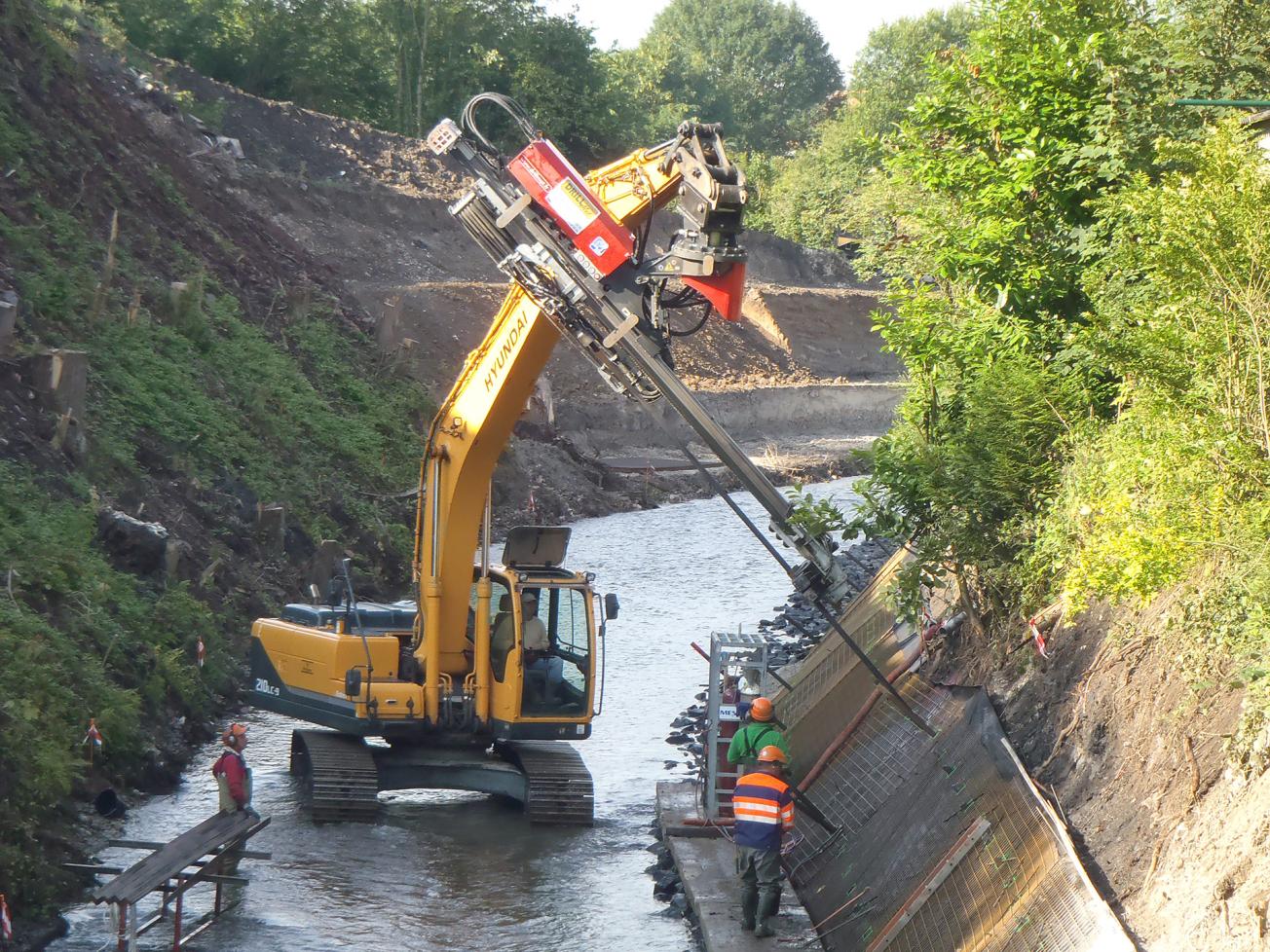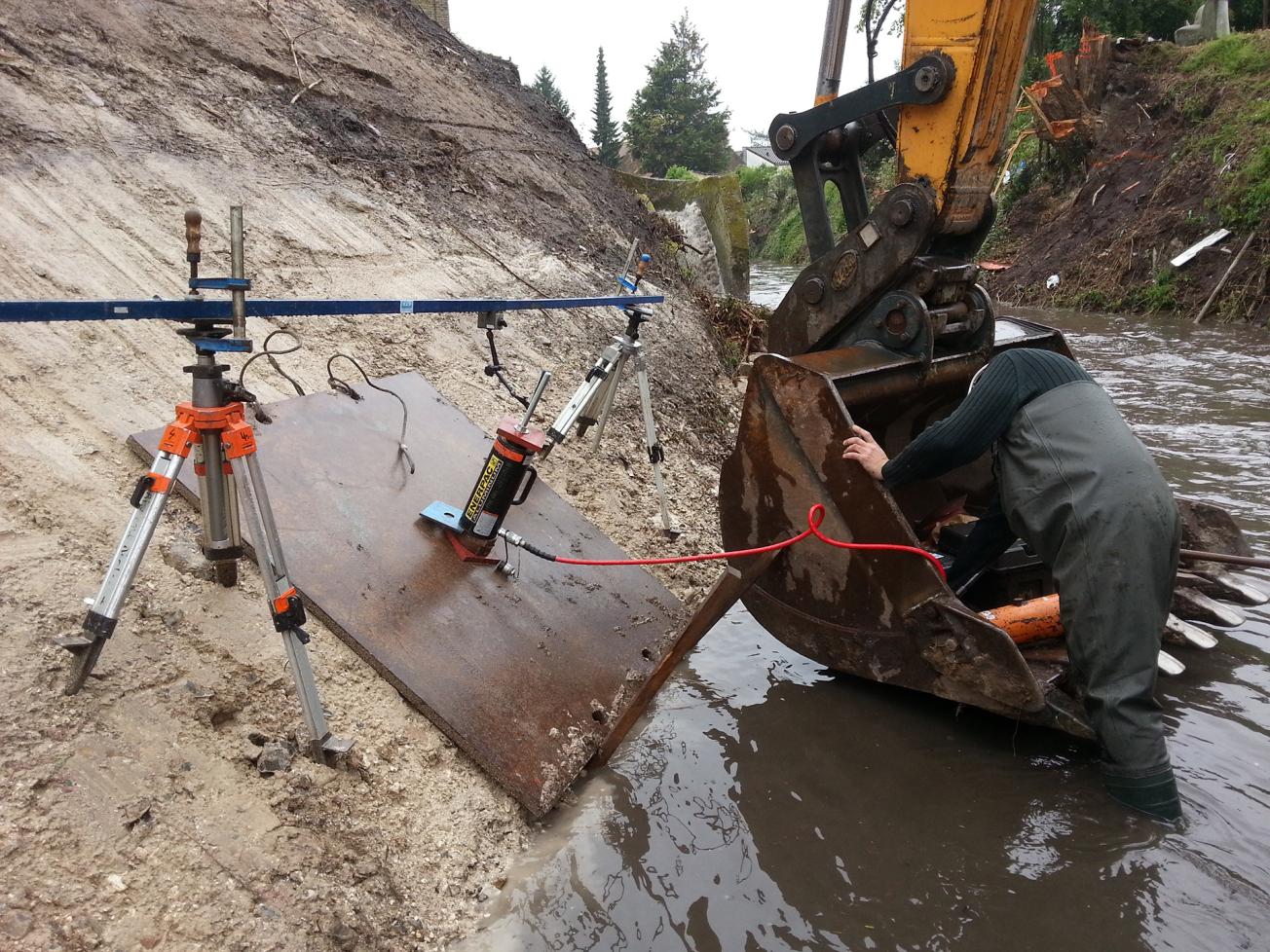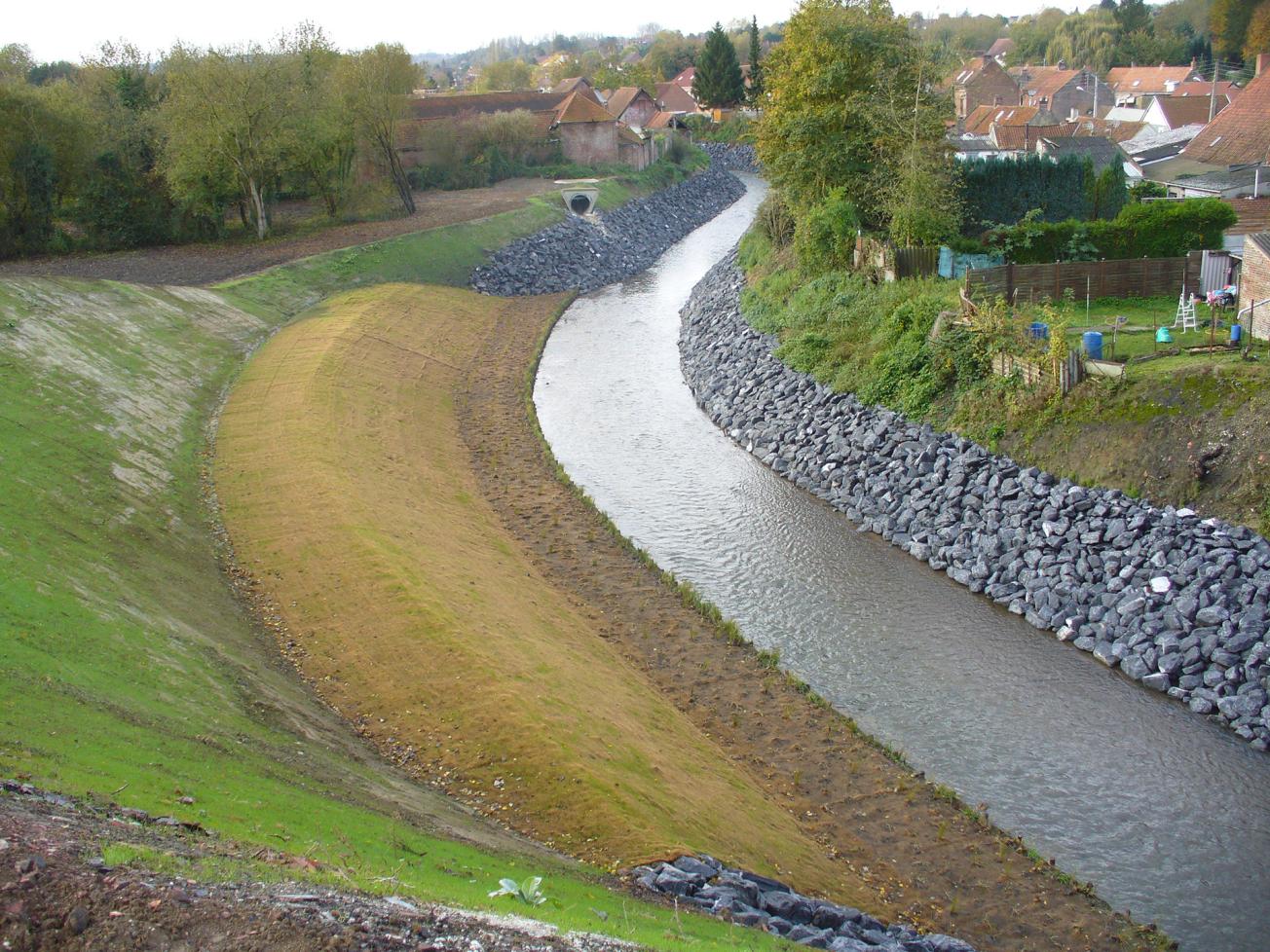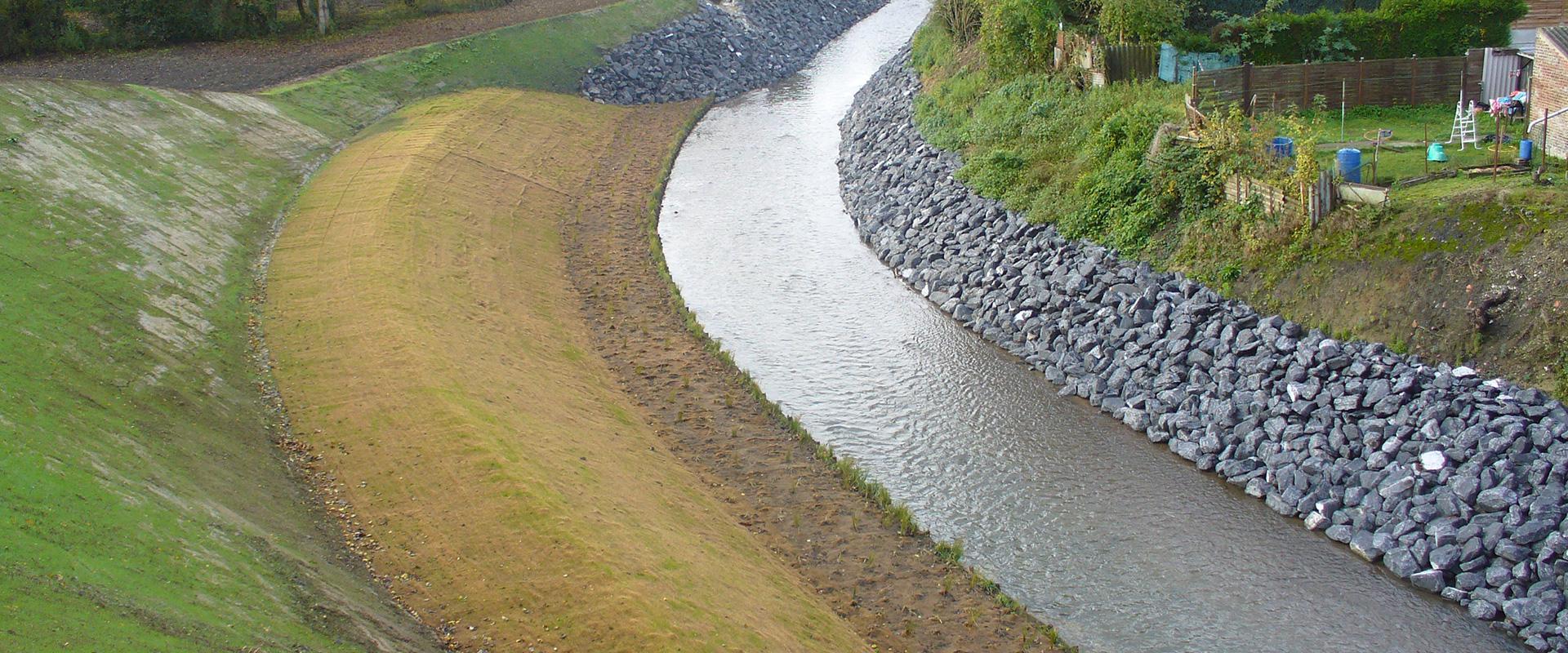Post-mining: consolidation of the Lawe riverbanks
Transcription
In the Nord-Pas-de-Calais coal basin, subsidence bowls are one of the main consequences of coal mining in the 19th and 20th centuries. The town of Bruay-la-Buissière is a case in point. The mining of 103 veins at depths of 100 to 1,200 metres has caused surface subsidence of over 10 metres. Serious topographical evolutions necessitated in changes to the course of the Lawe, which flows through this affected area. Today, these developments are no longer sufficient.
The river was deviated from its original bed. So today, we have a watercourse that's very closed in between very steep and very unstable embankments. The risk is that one or several of these embankments could collapse, block the watercourse and cause flooding upstream. And as part of the town lies beneath the water level, this would result in considerable damage.
So it was indispensable to securitise people who are threatened by flooding while also respecting all environmental constraints. In 2014, the BRGM was appointed by the government to oversee the delegated work to strengthen the riverbanks.
Since May 15th, we have made two stretches of 800 meters of embankments safe. We intervened in all the preliminary work. This consisted in pruning all the trees and clearing the undergrowth on the embankments. Then, due to the fact that the river is very hemmed in, we had to construct heavy gravel worksite tracks and to consolidate the riverbed so that our heavy equipment could manoeuvre in total safety.
Once the access work was completed, the BRGM stripped the embankments that were 2 to 5 meter high. Geotextile was then laid along the banks. On top of this, welded wire mesh was laid. After that, angle sections were hammered into the ground, and the reinforced concrete screening was sprayed on. This support method known as the "Hurpinoise Process" was used on 90% of this stretch of embankments. Only two sectors required a special treatment.
We had a wall too close behind, and we couldn't demolish it and use a classic method. So in front of it, we installed sheet-steel piling to ensure the stability of the wall, which has no foundations. This will also safeguard the house behind the wall.
The sheet-steel piling was put in place with a hydraulic jack. This jack eliminates all vibration problems which could destabilise the brick wall.
Also, along a tiny part of the stretch, on which we had enough grip to reduce the slope of the banks and flatten the earth, we planted an ecological reed garden on the different embankment levels.
Once this work was complete, the banks were rocked up, sodded with grass and planted with numerous species of greenery, all to produce a natural and safe environment.
Depressions formed by subsidence are one of the main consequences of mining in the Nord-Pas-de-Calais coal basin, where coal extraction was systematically followed by blasting the mine cavities rather than infilling. The resulting subsidence has formed localised depressions on the surface, sometimes several metres in diameter, which are liable to modify natural water flows.
To prevent flooding from the many rivers flowing through the area, the mining companies had to build dykes or even divert the rivers, as in the case of Bruay-la-Buissière, where subsidence has produced depressions some 10 m in width close to the Lawe, a small tributary of the Escaut River. Before safety work could begin on an upstream dyke protecting more than 1,000 inhabitants, the BRGM first had to consolidate the Lawe riverbanks.

"Hurpinoise" riverbank consolidation method: hammering bolts into a welded mesh.
© BRGM - Eric Locatelli
Riverbanks on the verge of collapse, dykes breached...
The Lawe is typical of rivers affected by past mining activities. Coal mining during the 19th and 20th centuries in the Nord-Pas-de-Calais coal basin had weakened the subsoil. The Bruay-la-Buissière concession is one example among many: mining of its 103 coal seams, at depths of 100 to 1,200 metres, has caused subsidence on the surface to form depressions up to 10 metres across. Due to these significant changes to the topography, decisions were made to adapt the flow of the river running through the centre of the zone, by diverting its course and building artificial embankments, dykes and levees. But the problems continued: riverbanks on the verge of collapse, dykes breached, and even floods, as in 1999, when several hundred houses were flooded.

Testing the pull resistance of the bolts.
© BRGM - Eric Locatelli
Social responsibility and sustainable development
As part of its surveillance mission, the DPSM is already responsible for managing the dyke on the left bank of the Lawe, which has needed repairs on many occasions to ensure its stability over time and to comply with new standards (raising of the dyke, design and follow-up of a series of cofferdams, analyses of the regulations, etc.). Given the consequences of mining on the downstream banks, the BRGM also conducted, as the State-delegated project manager, consolidation work involving shotcreting and strapping retaining walls, reprofiling banks and installing sheet pile walls. In 2014, the State commissioned the BRGM to handle engineering work to reinforce unstable sections along very steep and narrow parts of the river bank.
This civil engineering work, entirely performed from the river bed itself and in strict compliance with environmental obligations, supplemented the efforts of the previous mine owner to remedy the effects of the mine closures and thus ensure the safety of people exposed to flooding. The aim was to ensure that in the event of a riverbank collapse, the dyke upstream would not be submerged. The work was undertaken in several sectors of Bruay-la-Buissière, along 800 m of riverbank altogether and on both sides.

Ecological landscaping of the consolidated riverbank.
© BRGM - Christian Bocquillon
The first task was to fell riverside trees and build access ramps to the river bed. This was followed by overall consolidation using rockfill with anchoring bolts over a geotextile and a welded mesh, with hammered angle irons (“Hurpinoise” method) and shotcrete. Two zones needed special treatment: re-profiling of the riverbank with a reed bed planted at the foot in one case, and installation of a sheet pile wall to protect a house. Although the engineering work itself was fairly routine, it had to be performed along a small river (5 metres in width) that narrows sharply at certain points into gorges some 15 metres in depth.
Projects such as these are a matter of social responsibility and directly linked to the principles of sustainable development. This DPSM project exemplifies the BRGM’s approach by taking the different environmental, social, economic and technical aspects into account.








Subsidence bowls are one of the main consequences of mining in the Nord-Pas-de-Calais coalfield. This is the case in Bruay-la-Buissière where 10-metre-deep subsidence occurred near the Lawe, a small river that is a tributary of the Escaut (Pas-de-Calais, 2017).